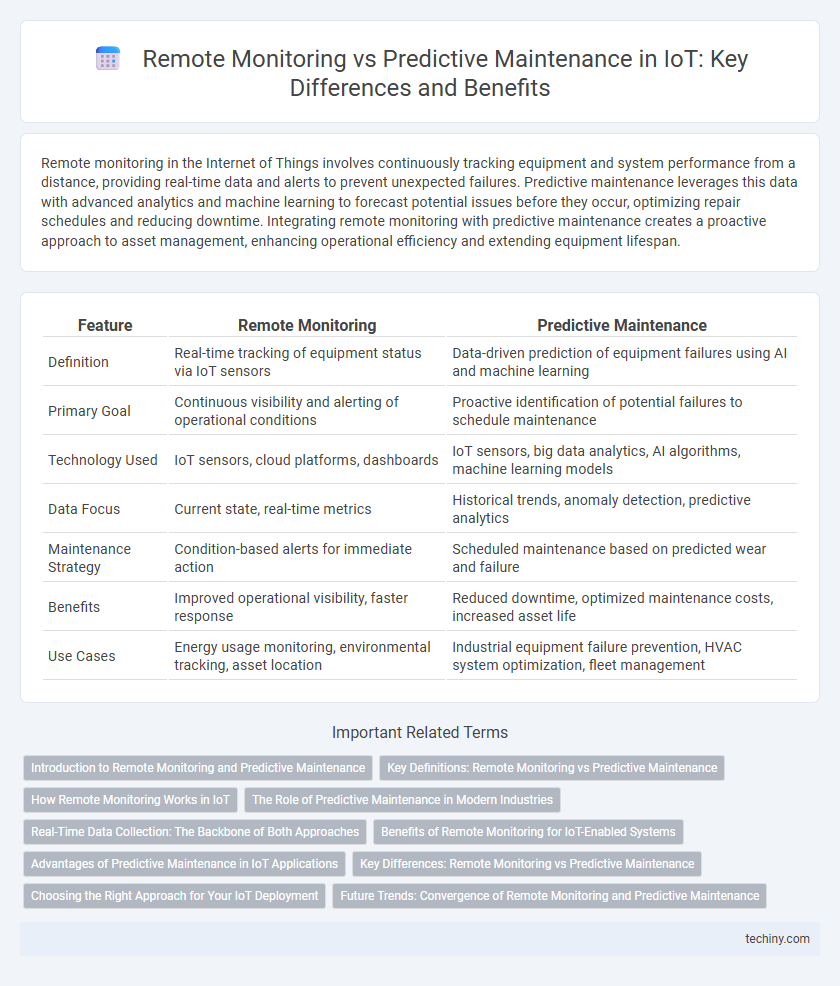Remote monitoring in the Internet of Things involves continuously tracking equipment and system performance from a distance, providing real-time data and alerts to prevent unexpected failures. Predictive maintenance leverages this data with advanced analytics and machine learning to forecast potential issues before they occur, optimizing repair schedules and reducing downtime. Integrating remote monitoring with predictive maintenance creates a proactive approach to asset management, enhancing operational efficiency and extending equipment lifespan.
Table of Comparison
| Feature | Remote Monitoring | Predictive Maintenance |
|---|---|---|
| Definition | Real-time tracking of equipment status via IoT sensors | Data-driven prediction of equipment failures using AI and machine learning |
| Primary Goal | Continuous visibility and alerting of operational conditions | Proactive identification of potential failures to schedule maintenance |
| Technology Used | IoT sensors, cloud platforms, dashboards | IoT sensors, big data analytics, AI algorithms, machine learning models |
| Data Focus | Current state, real-time metrics | Historical trends, anomaly detection, predictive analytics |
| Maintenance Strategy | Condition-based alerts for immediate action | Scheduled maintenance based on predicted wear and failure |
| Benefits | Improved operational visibility, faster response | Reduced downtime, optimized maintenance costs, increased asset life |
| Use Cases | Energy usage monitoring, environmental tracking, asset location | Industrial equipment failure prevention, HVAC system optimization, fleet management |
Introduction to Remote Monitoring and Predictive Maintenance
Remote monitoring in the Internet of Things (IoT) involves continuous data collection from connected devices to track performance and detect anomalies in real-time. Predictive maintenance leverages advanced analytics and machine learning algorithms on IoT data to forecast equipment failures before they occur, minimizing downtime and repair costs. These technologies collectively enhance operational efficiency by transitioning from reactive to proactive asset management.
Key Definitions: Remote Monitoring vs Predictive Maintenance
Remote monitoring in the Internet of Things (IoT) refers to the continuous collection and analysis of data from connected devices to track performance and detect anomalies in real time. Predictive maintenance utilizes this data alongside machine learning algorithms to forecast equipment failures before they occur, enabling proactive repairs that reduce downtime and costs. Both technologies leverage IoT sensors and data analytics but differ in their approach: remote monitoring focuses on real-time visibility, while predictive maintenance emphasizes future fault prediction.
How Remote Monitoring Works in IoT
Remote monitoring in IoT involves continuously collecting real-time data from connected sensors embedded in equipment, enabling immediate visibility into operational status and environmental conditions. This data is transmitted via IoT gateways to cloud-based platforms where analytics and dashboards provide alerts and performance metrics to stakeholders. The seamless integration of wireless communication protocols like MQTT and Wi-Fi ensures efficient data flow, supporting proactive decision-making and rapid issue detection in industrial IoT environments.
The Role of Predictive Maintenance in Modern Industries
Predictive maintenance leverages IoT sensors and data analytics to forecast equipment failures before they occur, minimizing downtime and reducing maintenance costs. Unlike remote monitoring, which simply tracks real-time conditions, predictive maintenance employs machine learning algorithms to analyze historical and real-time data for proactive interventions. This approach enhances operational efficiency, extends asset lifespan, and supports data-driven decision-making in modern manufacturing and industrial environments.
Real-Time Data Collection: The Backbone of Both Approaches
Real-time data collection serves as the backbone of both remote monitoring and predictive maintenance in the Internet of Things ecosystem, enabling continuous surveillance and instant detection of system anomalies. Sensors embedded in IoT devices capture instantaneous metrics such as temperature, vibration, and pressure, facilitating timely insights that optimize asset performance and minimize downtime. This immediate data stream supports informed decision-making by triggering alerts for remote monitoring and powering predictive algorithms for maintenance scheduling.
Benefits of Remote Monitoring for IoT-Enabled Systems
Remote monitoring in IoT-enabled systems enhances real-time data collection and system visibility, enabling timely detection of anomalies and reducing downtime. It significantly lowers operational costs by minimizing the need for on-site inspections and enabling remote troubleshooting. Improved asset performance and extended equipment lifespan result from continuous monitoring and immediate response to potential issues.
Advantages of Predictive Maintenance in IoT Applications
Predictive maintenance in IoT applications leverages real-time sensor data and advanced analytics to anticipate equipment failures before they occur, reducing downtime and maintenance costs. This approach enhances asset lifespan by enabling timely interventions based on accurate condition monitoring rather than scheduled checks. IoT-enabled predictive maintenance improves operational efficiency, optimizes resource allocation, and increases overall productivity compared to traditional remote monitoring methods.
Key Differences: Remote Monitoring vs Predictive Maintenance
Remote monitoring continuously collects real-time data from IoT-connected devices, enabling instant status updates and fault detection. Predictive maintenance leverages advanced analytics and machine learning algorithms on this data to forecast potential equipment failures and schedule maintenance proactively. The key difference lies in remote monitoring's focus on current conditions, while predictive maintenance emphasizes anticipating future issues to minimize downtime.
Choosing the Right Approach for Your IoT Deployment
Selecting between remote monitoring and predictive maintenance for IoT deployments hinges on specific operational goals and asset criticality. Remote monitoring provides real-time data collection and alerts, ideal for continuous oversight of equipment status and environmental conditions. Predictive maintenance leverages historical and sensor data analytics to anticipate failures, reducing downtime and optimizing maintenance schedules for complex machinery.
Future Trends: Convergence of Remote Monitoring and Predictive Maintenance
The convergence of remote monitoring and predictive maintenance is revolutionizing the Internet of Things by integrating real-time data analytics with machine learning algorithms to proactively address equipment failures. Advanced IoT sensors combined with AI-driven predictive models enable seamless condition-based monitoring, minimizing downtime and optimizing asset performance. Future trends emphasize edge computing and 5G connectivity to enhance data processing speed and accuracy, driving smarter, more autonomous maintenance ecosystems.
Remote Monitoring vs Predictive Maintenance Infographic

 techiny.com
techiny.com